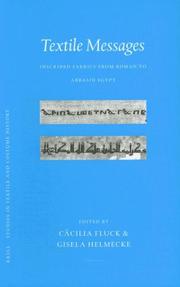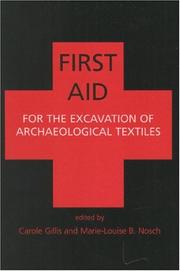| Listing 1 - 10 of 17 | << page >> |
Sort by
|
Book
ISBN: 1785708015 178570799X 9781785707995 9781785707988 1785707981 Year: 2017 Publisher: Oxford : Oxbow Books,
Abstract | Keywords | Export | Availability | Bookmark
 Loading...
Loading...Choose an application
- Reference Manager
- EndNote
- RefWorks (Direct export to RefWorks)
Book
ISBN: 3030921697 3030921700 Year: 2022 Publisher: Cham, Switzerland : Springer Nature Switzerland AG,
Abstract | Keywords | Export | Availability | Bookmark
 Loading...
Loading...Choose an application
- Reference Manager
- EndNote
- RefWorks (Direct export to RefWorks)
Textile fabrics, Ancient. --- Textile industry. --- Textile industry and fabrics --- Textiles industry --- Manufacturing industries --- Ancient textile fabrics
Book
ISBN: 1785700596 9781785700590 9781785700613 1785700618 9781785700606 178570060X 9781785700583 1785700588 1789257344 Year: 2016 Publisher: Oxford Philadelphia
Abstract | Keywords | Export | Availability | Bookmark
 Loading...
Loading...Choose an application
- Reference Manager
- EndNote
- RefWorks (Direct export to RefWorks)
Textile fabrics, Ancient --- Decoration and ornament, Ancient --- Bronze age --- Decorative Arts --- Visual Arts --- Art, Architecture & Applied Arts --- Ancient textile fabrics
Book
ISBN: 9781842174371 1842174371 9781842176955 1842176951 4002052869 Year: 2012 Volume: 10 Publisher: Oxford : Oakville, Conn. : Oxbow Books ; David Brown Book Co.,
Abstract | Keywords | Export | Availability | Bookmark
 Loading...
Loading...Choose an application
- Reference Manager
- EndNote
- RefWorks (Direct export to RefWorks)
Wearing the Cloak contains nine stimulating chapters on Roman military textiles and equipment that take textile research to a new level. Hear the sounds of the Roman soldiers' clacking belts and get a view on their purchase orders with Egyptian weavers. Could armour be built of linen? Who had access to what kinds of prestigious equipment? And what garments and weapons were deposited in bogs at the edge of the Roman Empire? The authors draw upon multiple sources such as original textual and scriptural evidence, ancient works of art and iconography and archaeological records and finds. The chapt
Textile fabrics, Roman --- Textile fabrics, Ancient. --- Military uniforms --- History. --- Materials. --- Rome --- Army --- Uniforms --- Equipment. --- Ancient textile fabrics --- Uniforms. --- Military antiquities. --- Antiquities
Book
ISBN: 1842177176 1842177192 9781842177181 1842177184 9781842177198 9781842177174 9781842176641 1842176641 Year: 2013 Publisher: Oxford Oxbow Books
Abstract | Keywords | Export | Availability | Bookmark
 Loading...
Loading...Choose an application
- Reference Manager
- EndNote
- RefWorks (Direct export to RefWorks)
Archaeology --- Textile fabrics, Ancient --- Textile fabrics --- Ancient textile fabrics --- Cloth --- Fabrics --- Textile industry and fabrics --- Textiles --- Decorative arts --- Dry-goods --- Weaving --- Textile fibers --- Analysis --- Conferences - Meetings --- Textile fabrics -- Analysis -- Congresses.. --- Textile fabrics, Ancient -- Analysis -- Congresses.. --- Archaeology -- Congresses. --- Textile chemistry

ISBN: 9004149562 9789004149564 1134572921 1280290250 9786610290253 0203015630 9780203015636 0415232228 9780415232227 9780415364577 0415364574 6610290253 9781134572878 9781134572915 9781134572922 9789047418290 1134572913 Year: 2006 Volume: 4 Publisher: Leiden Brill
Abstract | Keywords | Export | Availability | Bookmark
 Loading...
Loading...Choose an application
- Reference Manager
- EndNote
- RefWorks (Direct export to RefWorks)
Easy to read, and highly topical, Messages writes a history of mass communication in Europe and its outreaches, as a search for the origins of media forms from print and stage, to photography, film and broadcasting.Arguing that the development of the mass media has been an essential engine driving the western concept of an individual, Brian Winston examines how the right of free expression is under attack, and how the roots of media expression need to be recalled to make a case for the media's importance for the protection of individual liberty.Relating
Textile fabrics, Ancient --- Textiles et tissus antiques --- Textile fabrics [Ancient ] --- Egypt --- Congresses --- Textile fabrics --- Inscriptions --- Mass media --- History. --- Cloth --- Fabrics --- Textile industry and fabrics --- Textiles --- Ancient textile fabrics --- History --- Decorative arts --- Dry-goods --- Weaving --- Textile fibers --- Médias --- Histoire --- Égypte --- Manufacturing technologies --- inscriptions --- textile materials
Book
ISBN: 9781782977155 9781782977186 1782977163 178297718X 9781782977162 9781782977179 1782977171 1782977155 9781336208612 1336208619 Year: 2014 Volume: 19 Publisher: Oxford: Oxbow books,
Abstract | Keywords | Export | Availability | Bookmark
 Loading...
Loading...Choose an application
- Reference Manager
- EndNote
- RefWorks (Direct export to RefWorks)
Twenty chapters present the range of current research into the study of textiles and dress in classical antiquity, stressing the need for cross and inter-disciplinarity study in order to gain the fullest picture of surviving material. Issues addressed include: the importance of studying textiles to understand economy and landscape in the past; different types of embellishments of dress from weaving techniques to the (late introduction) of embroidery; the close links between the language of ancient mathematics and weaving; the relationships of iconography to the realities of clothed bodies including a paper on the ground breaking research on the polychromy of ancient statuary; dye recipes and methods of analysis; case studies of garments in Spanish, Viennese and Greek collections which discuss methods of analysis and conservation; analyses of textile tools from across the Mediterranean; discussions of trade and ethnicity to the workshop relations in Roman fulleries. Multiple aspects of the production of textiles and the social meaning of dress are included here to offer the reader an up-to-date account of the state of current research. The volume opens up the range of questions that can now be answered when looking at fragments of textiles and examining written and iconographic images of dressed individuals in a range of media. The volume is part of a pair together with Prehistoric, Ancient Near Eastern and Aegean Textiles and Dress: an interdisciplinary anthology, edited by Mary Harlow, Cécile Michel and Marie-Louise Nosch.
Textile fabrics, Ancient --- Textile fabrics, Roman --- Clothing and dress --- History --- Textile fabrics, Roman. --- Textiles et tissus antiques --- Textiles et tissus romains --- Costume --- Histoire --- Apparel --- Clothes --- Clothing --- Clothing and dress, Primitive --- Dress --- Dressing (Clothing) --- Garments --- Beauty, Personal --- Manners and customs --- Fashion --- Undressing --- Roman textile fabrics --- Ancient textile fabrics --- E-books --- Textile fabrics, Ancient - Greece --- Clothing and dress - Greece - History - To 500 --- Clothing and dress - Rome

ISBN: 178297444X 1782974423 9781782974420 9781782974444 9781842172230 1842172239 Year: 2007 Publisher: Oxford Oxbow Books
Abstract | Keywords | Export | Availability | Bookmark
 Loading...
Loading...Choose an application
- Reference Manager
- EndNote
- RefWorks (Direct export to RefWorks)
This small booklet is an important conservation guide. It deals with the special care required in order to deal with these delicate fabrics during their excavation and recording. It is included as an appendix in Ancient Textiles: Production, Crafts and Society
Archaeology -- Methodology. --- Arche ́ologie -- Me ́thodologie. --- Textile fabrics, Ancient. --- Textile fabrics. --- Textiles et tissus antiques. --- Textiles et tissus. --- Textile fabrics --- Textile fabrics, Ancient --- Archaeology --- Anthropology --- Social Sciences --- Social & Cultural Anthropology --- Archeology --- Auxiliary sciences of history --- History --- Antiquities --- Ancient textile fabrics --- Cloth --- Fabrics --- Textile industry and fabrics --- Textiles --- Decorative arts --- Dry-goods --- Weaving --- Textile fibers --- Methodology --- Conservation. Restoration --- textile materials --- archaeological objects --- preserving
Book
ISBN: 131541564X 1315415658 1611328896 9781611328899 1315415631 9781611328875 161132887X Year: 2016 Publisher: Walnut Creek Left Coast Press
Abstract | Keywords | Export | Availability | Bookmark
 Loading...
Loading...Choose an application
- Reference Manager
- EndNote
- RefWorks (Direct export to RefWorks)
This innovative volume challenges contemporary views on material culture by exploring the relationship between wrapping materials and practices and the objects, bodies, and places that define them. Using examples as diverse as Egyptian mummies, Celtic tombs, Native American ceremonial bundles, baby swaddling, and contemporary African textiles, the dozen archaeologist and anthropologist contributors show how acts of wrapping and unwrapping are embedded in beliefs and thoughts of a particular time and place. These context specific, cultural, and technical acts offer a new lens on material culture and its relationship to cultural meaning.
Wrapping cloths --- Material culture --- Textile fabrics --- Textile fabrics, Ancient --- Funeral rites and ceremonies, Ancient --- Ancient funeral rites and ceremonies --- Ancient textile fabrics --- Cloth --- Fabrics --- Textile industry and fabrics --- Textiles --- Decorative arts --- Dry-goods --- Weaving --- Textile fibers --- Culture --- Folklore --- Technology --- Cloth wrappers --- Wrapping materials
Book
ISBN: 1785700634 9781785700637 9781785700651 1785700650 9781785700620 1785700626 Year: 2016 Publisher: Oxford Philadelphia
Abstract | Keywords | Export | Availability | Bookmark
 Loading...
Loading...Choose an application
- Reference Manager
- EndNote
- RefWorks (Direct export to RefWorks)
"11 papers which focus on the process of textile manufacture, the weaving process itself, and the materiality of fabric. Contributions address the problematic issues of cognitive archaeology, consumer research, literary theory and themes addressing both philosophical history and the history of reception of ideas and practice. The contributions seek both to close the critical gaps with respect to weaving, a broad and complex field in the area of ancient cultural techniques, and to identify new themes. Accordingly, the submissions expand our focus into late antiquity, to integrate texts such as letters written on Papyrus detailing the everyday correspondence of an Egyptian family or to spotlight the meaning of textile terms and the history of misunderstandings associated therein. Frequently overused analogies between writing and weaving are also examined in terms of their legitimacy as well as their limits. The papers presented here result from an international and interdisciplinary conference under the same title held in Castelen, near Basel in 2012"--Provided by publisher.
Textile fabrics, Ancient --- Textile industry --- Weaving --- Manuscripts --- Writing --- Chirography --- Handwriting --- Language and languages --- Ciphers --- Penmanship --- Codices --- Books --- Nonbook materials --- Archival materials --- Charters --- Codicology --- Diplomatics --- Illumination of books and manuscripts --- Paleography --- Transmission of texts --- Ancient textile fabrics --- Warping --- Textile industry and fabrics --- Textiles industry --- Manufacturing industries --- Research --- History --- Social aspects
| Listing 1 - 10 of 17 | << page >> |
Sort by
|

 Search
Search Feedback
Feedback About UniCat
About UniCat  Help
Help News
News